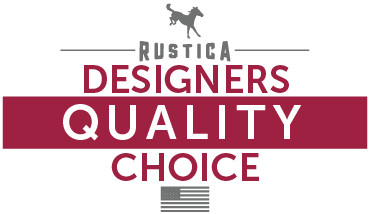





{{productSorter()}}
Are you looking to bring a new, inspired feel into your space? Rustica’s selection of sliding barn doors are made with the highest quality solid woods in the widest variety of styles, finishes and options, allowing you to customize your interior barn door to perfectly match your taste. Whether you’re looking for a custom barn door made of reclaimed wood or want something with a large, glass panel to let in lots of natural light—we have the perfect barn door for you!
Despite our rustic barn door roots, we offer a wide variety of styles to best match the look of our customers homes. From modern and minimal glass barn doors to our industrial metal barn doors there truly is something for every design type. Due to our vast array of options on all of our interior barn doors, we’re confident each customer will complete their purchase feeling inspired by the fact that their door is truly one of a kind. You can customize your look even further with our patented sliding barn door hardware.
Although interior barn doors are most commonly used in bedroom, living room, and kitchen applications, they are also very popular for the office, bathroom, laundry room, and family rooms. Barn doors can also be used as beautiful wall art or barn door shutters for windows, and are perfect for saving space in already cramped rooms. Each style is customizable to act as functional art piece to bring soul to your living space.
Rustica’s collection of sliding barn doors for your home are thoughtfully designed here in Utah in the most popular styles, with a vast array of options to fit your space.
A barn door is a sliding door that can be installed anywhere in a home where space allows. Historically, barn doors have been used as exterior sliding doors to enter and exit a barn. Today, barn doors are often used as interior sliding doors in homes to save space and add a decorative touch. Depending on the look you want, barn doors can add a modern style or rustic flair to a living space. There are many styles to choose from, both in hardware and the doors themselves.
Barn doors can be installed as a single sliding door or double sliding door, and there is a wide range of sliding barn door hardware options to fit every door style and purpose. In the interior of a home, you can find single sliding barn doors used for a closet, a bathroom, pantry, utility space, and more. Double barn doors can be used in wider openings, such as in a main living space or an office. Exterior barn doors are also popular for front or back entrances. You can improve your interior design in a unique way with sliding barn doors—no matter if you are inclined to a modern barn door style, a rustic style or somewhere in between.
Barn doors have become a trendy and unique design feature for many homeowners. Whether you’re building a new house or remodeling a room, a barn door can be a great addition to your home.
Barn doors are beloved for being a great design feature in a home. Interior barn doors can make a huge statement in any area, whether it be in a pantry, master bath, living room, or barn door closet. They are both functional and stylish, and add a much more decorative style than traditional doors.
Depending on the hardware finishes and barn door design options (color, material, finish, etc.), your sliding barn door can offer a modern feel or a more rustic style. There are glass and stainless steel options for a more refined look, or knotty alder and metal options that can provide an urban vibe. No matter which style you choose, you can make your interior space pop with custom sliding barn doors.
Our interior sliding barn doors are available in a wide variety of styles. Not only can you add different decorative hardware options, but the barn door itself comes in a wide variety of sizes, designs, paint colors, and stain finishes.
There are both single and double barn doors available, or you may prefer bypass barn doors for a unique touch. Double sliding barn doors are a great idea for large openings in any living space. There is a wide range of options for finishes, such as mirrors on one side of the barn door, French finishes, glass options, five-panel finishes, and more. We make it easy for you create a custom door with a style that’s truly your own.
While your interior barn doors can be customized to fit your unique style, it’s the sliding barn door hardware you choose that really makes a statement and sets your barn door apart. There are many hardware options that can help make your barn door unique. Whether you prefer modern or rustic barn door designs, the right fixtures will add a decorative element to your living space—latches and locks, pulls and handles, timber plates, tracks, and more. You can purchase each fixture piece separately, or you can choose to purchase a barn door kit for a full set of matching finishes.
You may be wondering how to install a barn door yourself. The ease of installation is one of the best benefits of barn doors, and you don’t have to be an expert handyman.
If you plan to install your sliding barn door yourself, you have a few options. You can choose to buy custom barn doors or convert doors that you already own. You may want to buy a barn door kit, which can be created to your specific space and measurement needs, or you can purchase sliding barn door hardware separately. A hardware kit is a great idea if you don’t want to hire help.
Sliding barn door installation is fairly simple. Traditional doors require a more complex installation process, but sliding doors, including sliding barn doors, only require a few pieces of hardware, including a track, brackets, and screws. And should you ever want to change your barn doors at some point in the future, it’s easy to remove an attached door and swap it out for another style.
Make sure there is enough wall space – double the width of your barn door. If you are using a barn door kit, you will simply need to follow the instructions for installing each piece of hardware, and you’ll have your very own interior sliding barn door before you know it.
Interior barn doors are a stylish way to save space. Because barn doors are sliding doors, they only take up wall space when they are open, rather than floor space. This gives you the ability to add more furniture or décor in your home and utilize the space to its fullest. You can even use barn doors as pocket doors, which slide into the wall, creating even more space. Pocket doors are completely hidden when they are open.
When you need to save space, a new barn door can be a great choice for a closet or master bathroom. They can help you save space in other areas of the home, such as a pantry, office, den, laundry room, and more. Certain types of sliding doors, such as glass barn doors, can open up a room and instantly make it feel bigger.
Although barn doors are often thought of as heavy and bulky, interior sliding barn doors are easy to operate and do not feel heavy. Since these doors slide on a track, interior sliding barn doors can open and close shut with little effort, no matter your choice of hardware. Whether you’re thinking about adding double barn doors that lead into your backyard or a single sliding barn door within your home, you will love the ease of use that comes with having a sliding door on a track.
Barn doors work very well in main living areas, providing a popular alternative to French doors for covering a wide opening. It makes a big statement when you use the full width of a large door frame with something stylish like rustic or modern barn doors.
If you want to close off a main living space from an office or another room, double sliding barn doors are a great idea. And for those who can’t decide between French doors and barn doors, keep in mind that we offer several French barn door styles with a variety of glass finish options.
Interior barn doors are sustainable and environmentally friendly. Since barn doors are made from high-quality wood, the barn door is both durable and a renewable resource. Barn wood doors are a great investment since they last a very long time without needing to be replaced.
Barn doors are also energy efficient. Glass panes will allow natural light into a room, and barn doors provide excellent insulation. They can also be used as window treatments to keep the sun at bay on hot summer days, lowering your utility bills.
With the right hardware, any door can become a sliding barn door. You will likely need to purchase specific finishes, such as latches or pulls, along with hardware, like your track system. Rustica sells a wide range of barn door hardware options to convert your current door into a sliding barn door. You can choose from stylish door handles and pulls door locks, track styles, ceiling mount hardware and more.
While it may seem like a great idea to convert your current door into a sliding barn door, it can be a challenging installation process. Since you need to configure your current door to work in a completely different manner, you can run into a lot of roadblocks. It will likely save you time and energy to buy a barn door and hardware kit together, which are made to fit together properly in your specific space.
If you are interested in interior doors for your home or office, barn doors may be the perfect choice. You can select from a wide range of barn door materials, including glass barn doors, barn wood doors, mirrored barn doors, and more. Sliding barn doors are more popular than ever, and it is easy to see why. With so many styles and options available, you can easily customize and design a sliding barn door that complements the unique style of your home.
If you want to install a barn door yourself, consider the benefits of a barn door kit. When you purchase a hardware kit and a barn door from Rustica, installation materials and instructions are included. You can have a beautiful sliding barn door in no time at all.
Rustica sliding barn doors for your home are thoughtfully designed here in Utah in the most popular styles, with a vast array of options to fit your space.